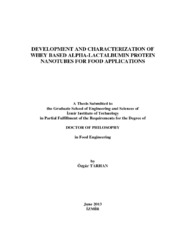Please use this identifier to cite or link to this item:
https://hdl.handle.net/11147/2955Full metadata record
| DC Field | Value | Language |
|---|---|---|
| dc.contributor.advisor | Harsa, Hayriye Şebnem | - |
| dc.contributor.author | Tarhan, Özgür | - |
| dc.date.accessioned | 2014-07-22T13:48:39Z | - |
| dc.date.available | 2014-07-22T13:48:39Z | - |
| dc.date.issued | 2013 | - |
| dc.identifier.uri | http://hdl.handle.net/11147/2955 | - |
| dc.description | Thesis (Doctoral)--Izmir Institute of Technology, Food Engineering, Izmir, 2013 | en_US |
| dc.description | Includes bibliographical references (leaves: 110-122) | en_US |
| dc.description | Text in Englisg; Abstract: Turkish and English | en_US |
| dc.description | xv, 128 leaves | en_US |
| dc.description | Full text release delayed at author's request until 2016.07.22 | en_US |
| dc.description.abstract | Alpha-lactalbumin (α-La) is one of the major proteins in whey. When partially hydrolyzed with protease, it produces nanotubular structures by self-assembly process. The aim of this PhD thesis is to develop and characterize whey based α-La nanotubes. In this study, purification of α-La from whey using ultrafiltration and chromatography, development of protein nanotubes with standard and purified α-La fractions, their characterization by microscopic, optical and spectrophotometric methods, analysis of hydrolysis process, and investigation of these nanotubes in relation to food applications were presented. Lactose was eliminated and proteins were concentrated in whey powder by diafiltration assisted ultrafiltration prior to chromatography. α-La and besides β- lactoglobulin were purified individually from whey protein concentrate with high purity (95–99 %). The obtained protein nanotubes were longer than 100 nm up to few microns with ~20 nm width in bundled, rod and chain-like fashions. Remarkable conformational changes occurred in the protein secondary structure during nanotube formation. Calcium to protein ratio critically affected nanotube formation and stability. Both hydrolysis and nanotube growth triggered gelation, but stiffer gel network was obtained with nanotubes. Viscoelasticity and stiffness were improved by blending with cellulose. As the calcium content increased the transparent appearance of the gels got turbid due to aggregation. α-La nanotubes were stable up to ~ 60 °C. The nanotubular gels entrapped a coloring agent by enhancing transparency. Binding of catechin to nanotubes was occured as reversible with low stability. α-La nanotubes and gels can be used as functional ingredients in food processing involving low and moderate heat treatments. | en_US |
| dc.language.iso | en | en_US |
| dc.publisher | Izmir Institute of Technology | en_US |
| dc.rights | info:eu-repo/semantics/openAccess | en_US |
| dc.subject.lcsh | Whey | en |
| dc.subject.lcsh | Lactalbumin | en |
| dc.subject.lcsh | Nanotubes | en |
| dc.title | Development and Characterization of Whey Based Alpha-Lactalbumin Protein Nanotubes for Food Applications | en_US |
| dc.type | Doctoral Thesis | en_US |
| dc.authorid | 0000-0001-7084-6253 | - |
| dc.institutionauthor | Tarhan, Özgür | - |
| dc.department | Thesis (Doctoral)--İzmir Institute of Technology, Food Engineering | en_US |
| dc.relation.publicationcategory | Tez | en_US |
| dc.identifier.wosquality | N/A | - |
| dc.identifier.scopusquality | N/A | - |
| item.openairecristype | http://purl.org/coar/resource_type/c_18cf | - |
| item.cerifentitytype | Publications | - |
| item.fulltext | With Fulltext | - |
| item.languageiso639-1 | en | - |
| item.grantfulltext | open | - |
| item.openairetype | Doctoral Thesis | - |
| Appears in Collections: | Phd Degree / Doktora | |
Files in This Item:
| File | Description | Size | Format | |
|---|---|---|---|---|
| 10009124.pdf | DoctoralThesis | 7.13 MB | Adobe PDF |  View/Open |
CORE Recommender
Page view(s)
360
checked on Apr 28, 2025
Download(s)
176
checked on Apr 28, 2025
Google ScholarTM
Check
Items in GCRIS Repository are protected by copyright, with all rights reserved, unless otherwise indicated.